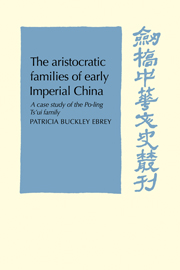Book contents
- Frontmatter
- Contents
- List of tables
- Acknowledgements
- Chronology of the Chinese dynasties
- 1 Introduction
- 2 The historical development of the aristocratic families
- 3 Origins of the Ts'uis in the Han
- 4 The Ts'uis in the aristocratic age
- 5 The Ts'uis as an old family in the T'ang
- 6 Implications and conclusions
- Notes to the text
- Appendix I The reliability of the genealogical tables in the Hsin T'ang shu
- Appendix II Annotated genealogy of the descendants of Ts'ui Yen, d. 646
- Appendix III Marriages of Po-ling Ts'uis during the T'ang
- Bibliography
- Glossary
- Index
2 - The historical development of the aristocratic families
Published online by Cambridge University Press: 04 August 2010
- Frontmatter
- Contents
- List of tables
- Acknowledgements
- Chronology of the Chinese dynasties
- 1 Introduction
- 2 The historical development of the aristocratic families
- 3 Origins of the Ts'uis in the Han
- 4 The Ts'uis in the aristocratic age
- 5 The Ts'uis as an old family in the T'ang
- 6 Implications and conclusions
- Notes to the text
- Appendix I The reliability of the genealogical tables in the Hsin T'ang shu
- Appendix II Annotated genealogy of the descendants of Ts'ui Yen, d. 646
- Appendix III Marriages of Po-ling Ts'uis during the T'ang
- Bibliography
- Glossary
- Index
Summary
The aristocratic families were never a single, unified group. It took centuries for a clearly defined aristocracy to emerge and even then new families appeared as old ones died out or declined. Moreover, the country was politically divided for extended periods with parts ruled by non-Chinese, creating regional and ethnic differences which distinguished groups of aristocratic families. For these reasons the history of the aristocratic families is not the history of a particular group of family lines, but the history of the rise, evolution, and decline of the aristocratic families as a social category.
The Han upper class
A large proportion of the aristocratic families of the third to eighth centuries A.D. appear to have descended from the ‘powerful families’ (hao-tsu, hao-chieh, ta-hsing, etc.) which formed the Han upper class. Because China proper was unified and a single imperial house was maintained for four centuries (with a brief interregnum when Wang Mang overthrew the Former Han), the Former and Later Han are considered among the great dynasties of Chinese history. Nevertheless caution should be used in estimating the degree to which the Han government controlled life in the countryside. The dynastic histories frequently mention ‘powerful families’ which dominated local areas. Their status derived largely from two private, informal matters: local standing and style of life. These families generally had a local base, an area where they owned land and had social and political influence.
- Type
- Chapter
- Information
- The Aristocratic Families in Early Imperial ChinaA Case Study of the Po-Ling Ts'ui Family, pp. 15 - 33Publisher: Cambridge University PressPrint publication year: 1978

